
Sampierdarena is a major port and industrial area of Genoa, in northwest Italy. With San Teodoro it forms the West Central municipio.
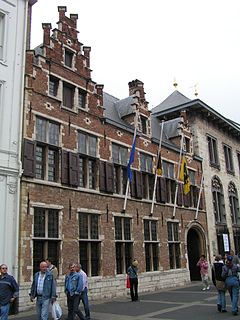
The Rubenshuis is the former home and workshop of Peter Paul Rubens (1577–1640) in Antwerp. Purchased in 1610, Rubens had the Flemish townhouse renovated and extended on the basis of designs by Rubens himself. After the renovations, the house and its courtyard garden had the outlook of an Italian palazzo, which reflected the artistic ideals of Rubens. The ensemble is now a museum dedicated mainly to the work of Rubens and his contemporaries.

Via Giuseppe Garibaldi is a street in the historical centre of Genoa, in Northwestern Italy, well known for its ancient palaces. It is one of the Strade Nuove built by the Genoese aristocracy during the Renaissance. Since July 2006 it is inscribed in the list of UNESCO World Heritage Site Genoa: the Strade Nuove and the system of the Palazzi dei Rolli.

The Palazzo Brignole Sale or Palazzo Rosso is a house museum located in Via Garibaldi, in the historical center of Genoa, in Northwestern Italy. The palace is part of the UNESCO World Heritage Site Genoa: Le Strade Nuove and the system of the Palazzi dei Rolli. The rich art collection inside, along with the galleries of Palazzo Bianco and Palazzo Doria Tursi, is part of the Musei di Strada Nuova and consists of the works of artists of the caliber of Antoon van Dyck, Guido Reni, Paolo Veronese, Guercino, Gregorio De Ferrari, Albrecht Dürer, Bernardo Strozzi and Mattia Preti.

Sir Peter Paul Rubens was a Flemish artist and diplomat from the Duchy of Brabant in the Southern Netherlands. He is considered the most influential artist of the Flemish Baroque tradition. Rubens's highly charged compositions reference erudite aspects of classical and Christian history. His unique and immensely popular Baroque style emphasized movement, colour, and sensuality, which followed the immediate, dramatic artistic style promoted in the Counter-Reformation. Rubens was a painter producing altarpieces, portraits, landscapes, and history paintings of mythological and allegorical subjects. He was also a prolific designer of cartoons for the Flemish tapestry workshops and of frontispieces for the publishers in Antwerp.

Genoa: Le Strade Nuove and the system of the Palazzi dei Rolli is a UNESCO World Heritage Site which includes a number of streets and palaces in the center of Genoa, in Northwestern Italy.

Lucas de Wael was a Flemish painter, art dealer and merchant. He was born in Antwerp and worked for some time in Genoa in Italy before returning to Antwerp. Here he continued his artistic and commercial activities. He is known for his landscapes and genre scenes.

Jan Baptist Barbé or Jan-Baptist Barbé (1578–1649) was a Flemish engraver, publisher and art dealer active in Antwerp. He is known for his engravings after his own designs as well as for his reproductive engravings.

Vincent Malo or Vincent Malo I was a Flemish painter who after training and working in Antwerp was mainly active in Italy, where he was known, amongst others, as Vincenzo Malo, Vincenzo Malò and Vincenzio Malo. He is known Vincent Malo was a painter of genre scenes and of religious and mythological subjects and occasional portraits.
Verdussen was a dynasty of printers in Antwerp, starting with Hieronymus Verdussen I in the late sixteenth century, and ending around 1800. Many other printers in Antwerp were also related to the Verdussens through marriage. They specialized in religious works and works in Spanish, but also published newspapers, almanachs, poetry, scientific works, .... By the end of the 17th century, they produced about 21% of the Spanish books printed in the Netherlands, and with 5 presses was second only to Moretus in Antwerp. In 1876, the Verdussenstraat was named after the family in Antwerp.

Frans Geffels, known in Italy as Francesco Geffels was a Flemish painter, printmaker, architect, stage designer and designer of ephemeral structures for solemn and festive occasions. After training in his native Antwerp, he was mainly active in Mantua, where he was prefetto delle fabbriche to the Duke, a role that gave him the direction of the artistic and construction activities undertaken by the Ducal court. He worked also on projects for the local aristocratic class of Mantua. In addition, he completed projects for the Liechtenstein princes and for the imperial court in Vienna.

Genoa is the capital of the Italian region of Liguria and the sixth-largest city in Italy. In 2015, 594,733 people lived within the city's administrative limits. As of the 2011 Italian census, the Province of Genoa, which in 2015 became the Metropolitan City of Genoa, had 855,834 resident persons. Over 1.5 million people live in the wider metropolitan area stretching along the Italian Riviera.

The Palazzo Angelo Giovanni Spinola is a palace located in Via Garibaldi, in the historical center of Genoa, in Northwestern Italy. It was one of the 163 Palazzi dei Rolli of Genoa, the selected private residences where the notable guests of the Republic of Genoa were hosted during State visits. On 13 luglio del 2006 it was included in the list of 42 palaces which now form the UNESCO World Heritage Site Genoa: Le Strade Nuove and the system of the Palazzi dei Rolli. Now owned by a bank, it is possible to visit the areas open to the public.
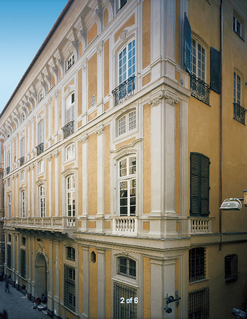
The Palazzo Doria or Palazzo Andrea e Gio. Batta Spinola is a palace located in Via Garibaldi, in the historical center of Genoa, in Northwestern Italy. It was one of the 163 Palazzi dei Rolli of Genoa, the selected private residences where the notable guests of the Republic of Genoa were hosted during State visits. On 13 luglio del 2006 it was included in the list of 42 palaces which now form the UNESCO World Heritage Site Genoa: Le Strade Nuove and the system of the Palazzi dei Rolli.
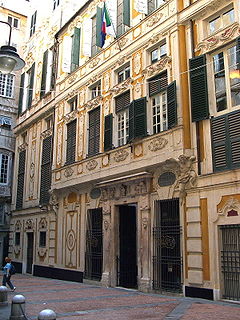
The Palazzo Spinola di Pellicceria, also known as Palazzo Francesco Grimaldi, is a palace located in piazza di Pellicceria in the historical center of Genoa, Northwestern Italy. The palace was one of the 163 Palazzi dei Rolli of Genoa, the selected private residences where the notable guests of the Republic of Genoa were hosted during State visits. On 13 luglio del 2006 it was added to the list of 42 palaces which now form the UNESCO World Heritage Site Genoa: Le Strade Nuove and the system of the Palazzi dei Rolli. It is currently owned by the Ministry of Cultural Heritage and Activities and Tourism and houses the National Gallery of Art in Palazzo Spinola.
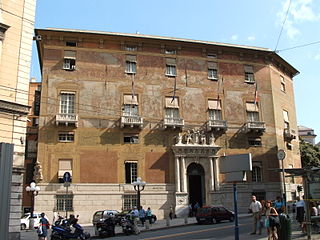
The Palazzo Doria-Spinola or Palazzo Antonio Doria is a palace located in largo Eros Lanfranco in the historical center of Genoa, Northwestern Italy. The palace was one of the 163 Palazzi dei Rolli of Genoa, one of those selected private residences where notable guests of the Republic of Genoa were hosted during State visits. On 13 luglio del 2006 it was added to the list of 42 palaces which now form the UNESCO World Heritage Site Genoa: Le Strade Nuove and the system of the Palazzi dei Rolli. The palace now hosts the Prefecture of Genoa and the seat of the Province of Genoa. It is possible to visit the areas of the building which are open to the public.
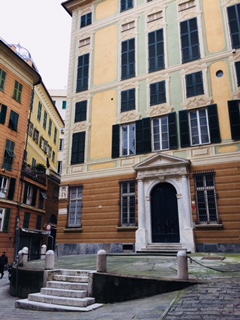
The Palazzo Clemente Della Rovere is a palace located in Piazza Rovere in the historical center of Genoa, Northwestern Italy. The palace was one of the 163 Palazzi dei Rolli of Genoa, the selected private residences where the notable guests of the Republic of Genoa were hosted during State visits. On 13 luglio 2006 it was added to the list of 42 palaces which now form the UNESCO World Heritage Site Genoa: Le Strade Nuove and the system of the Palazzi dei Rolli. The palace hosts today the General Consulate of Iceland.

Via Balbi is a street in the historical centre of Genoa, in Northwestern Italy, named after the aristocratic Genoese Balbi family. It is one of the Strade Nuove built by the Genoese aristocracy during the Renaissance. Since July 2006 it is inscribed in the list of UNESCO World Heritage Site Genoa: the Strade Nuove and the system of the Palazzi dei Rolli.

Via Cairoli is a street in the historical centre of Genoa, in North-western Italy, named after the 10th Prime Minister of Italy Benedetto Cairoli (1825-1889). Built in the 18th century as “Strada Nuovissima”, it is one of the Strade Nuove inscribed in July 2006 in the list of UNESCO World Heritage Site Genoa: the Strade Nuove and the system of the Palazzi dei Rolli.
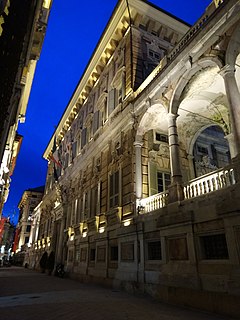
The palazzo Doria-Tursi or palazzo Niccolò Grimaldi is a building on Via Giuseppe Garibaldi in the historic town centre of Genoa. With Palazzo Rosso and Palazzo Bianco it houses the Strada Nuova Museums and on 13 July 2006 all three palaces and the streets around them became the Genoa: Le Strade Nuove and the system of the Palazzi dei Rolli World Heritage Site. Since 1848 Palazzo Doria-Tursi has also housed the city hall of Genoa.



















